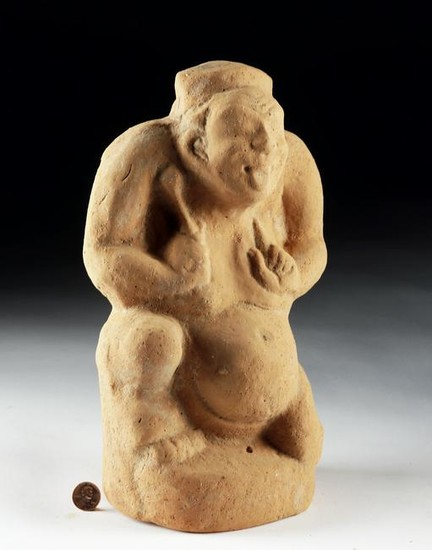Early Han Dynasty Terracotta Jester with Drum
East Asia, China, Han Dynasty, ca. 206 BCE to 220 CE. A wonderfully preserved example of a tomb attendant - a court jester-like figure, nude aside from a loose skirt that hangs below his broad belly and does not quite cover the top of his buttocks. He is crouched, holding drumsticks, one in each raised hand. His face is playful, with his tongue sticking out between his lips and his forehead furrowed as if in mirth. Who is this figure? Perhaps he is based on Dongfang Shuo, famous court jester to the Emperor Wu (r. 141 to 87 BCE). Size: 7.05" W x 11.05" H (17.9 cm x 28.1 cm)
Tomb attendants like this one are part of a class of artifacts called mingqi - sometimes known as "spirit utensils" or "vessels for ghosts". They became popular in the Han Dynasty and would persist for several centuries. Alongside figures like this one were musicians, athletes, animals, structures… Even though they were mass produced, mingqi of the Han Dynasty often show a high level of detail and naturalism. These were designed to assist the po, the part of the soul of the deceased that remained underground with the body while the hun, the other part of the soul, ascended. Caring for the po seems to have taken on a new level of meaning in the Han period, with more elaborate rituals and tomb construction arising.
Provenance: private Hawaii, USA collection, purchased in Hong Kong in the 1980s
All items legal to buy/sell under U.S. Statute covering cultural patrimony Code 2600, CHAPTER 14, and are guaranteed to be as described or your money back.
A Certificate of Authenticity will accompany all winning bids.
We ship worldwide to most countries and handle all shipping in-house for your convenience.
#141256
Condition Report: Intact, with nicely preserved features. Orange pigment on surface may not be original and is very fragile.
View it on
Estimate
Time, Location
Auction House
East Asia, China, Han Dynasty, ca. 206 BCE to 220 CE. A wonderfully preserved example of a tomb attendant - a court jester-like figure, nude aside from a loose skirt that hangs below his broad belly and does not quite cover the top of his buttocks. He is crouched, holding drumsticks, one in each raised hand. His face is playful, with his tongue sticking out between his lips and his forehead furrowed as if in mirth. Who is this figure? Perhaps he is based on Dongfang Shuo, famous court jester to the Emperor Wu (r. 141 to 87 BCE). Size: 7.05" W x 11.05" H (17.9 cm x 28.1 cm)
Tomb attendants like this one are part of a class of artifacts called mingqi - sometimes known as "spirit utensils" or "vessels for ghosts". They became popular in the Han Dynasty and would persist for several centuries. Alongside figures like this one were musicians, athletes, animals, structures… Even though they were mass produced, mingqi of the Han Dynasty often show a high level of detail and naturalism. These were designed to assist the po, the part of the soul of the deceased that remained underground with the body while the hun, the other part of the soul, ascended. Caring for the po seems to have taken on a new level of meaning in the Han period, with more elaborate rituals and tomb construction arising.
Provenance: private Hawaii, USA collection, purchased in Hong Kong in the 1980s
All items legal to buy/sell under U.S. Statute covering cultural patrimony Code 2600, CHAPTER 14, and are guaranteed to be as described or your money back.
A Certificate of Authenticity will accompany all winning bids.
We ship worldwide to most countries and handle all shipping in-house for your convenience.
#141256
Condition Report: Intact, with nicely preserved features. Orange pigment on surface may not be original and is very fragile.



